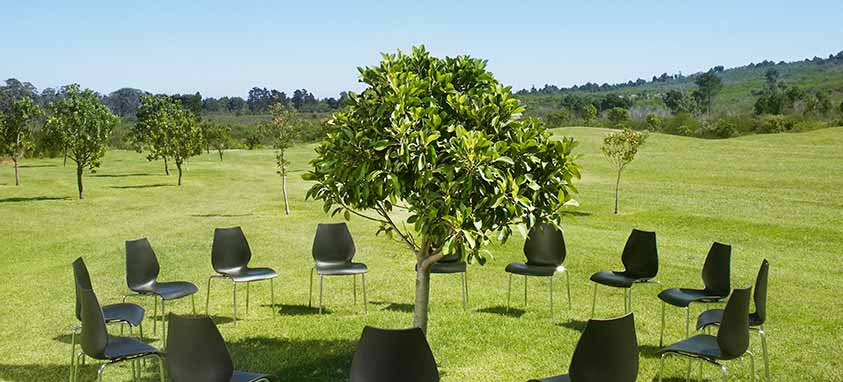Frustrated, confused or tired of green or sustainable meetings? You’re not alone. Between diverse standards, complicated issues and conflicting priorities sometimes it can seem easier to not bother. Over the last ten years Paul Salinger and Shawna McKinley have seen a lot of event sustainability ups and downs while steering responsibility efforts for Oracle events. They’ve seen ideas come and go, and learned (sometimes the hard way) what works and what doesn’t when it comes to developing and implementing a successful and manageable sustainable event program.
Fresh from our Smart Meetings Webinar Series, we bring you an in-depth Q&A with Salinger and McKinley as they answer some of our audience’s questions and provide insight on the best ways to green-up your events.
Where can one get the standards?
ISO 20121 is available for purchase via the ISO website. The APEX ASTM Environmentally Sustainable Event Standard is available for purchase via the Convention Industry Council website (which also includes some helpful FAQs). The Global Reporting Initiative Event Organizer’s Sector Supplement is a reporting standard, and is available for free via the GRI website.
Are there any certifications that event planners can obtain to demonstrate their green meeting expertise?
While the CMP has integrated more content related to sustainability, it obviously certifies broader expertise. So if you’re interested in demonstrating your expertise just for this aspect, the Sustainable Event Alliance offers an on-demand Accredited Professional designation that tests your expertise in event sustainability, including green meetings. The Green Meeting Industry Council and Meeting Professionals International have also run certificate courses in-person and virtually, so it can pay to see if there are any upcoming courses scheduled that you might join.
Are you aware of any venues adding a “green” savings on their invoices to validate a green savings?
Directly sharing cost savings from “green” venue practices is not a common thing. Mainly because the financial benefits of running a “greener” building are hard to translate to an event-specific context. Once you install thermal windows or upgrade to water-conserving fixtures, for example, the reduction in operating costs is universal, and experienced by everyone who uses the facility. You may not see a benefit on the invoice, but these features help keep costs of operating the building in check. The one exception can be waste which is variable event-to-event. Venues may itemize the bottom line benefit of reducing waste, which results in less garbage cost where this is charged separately. In some cases, venues will charge a reduced fee for recycling compared to landfill, and might itemize the cost-benefit. This is typically something you need to ask for, however, as it’s not automatically shared.
Would you say running a more sustainable event is more costly? If so, do you have examples on how to stay on budget?
When you are looking to gain support, savings help. However, there typically comes a point where the low-hanging, cost-saving fruit, such as reducing printing, are harvested, and you need to look at things that may be more costly. Ideally you try to do both at the same time: a little bit of cost saving on vegetarian entrees or portion control so you have a bit extra to invest in organic ingredients, for example. There are also opportunities for sponsorship to consider: Fair Trade breakfasts or breaks, pedometer challenges that promote walking and reduce shuttling, branded waste stations, or volunteer activities. These can actually help increase the budget. Another new and exciting option involves sharing materials and service providers across events. For example, approaching your venue CSM to see if you might contact organizers of events before and after you to economize on production costs by working with the same staging, AV or general services contractor.
How do you suggest promoting the event’s sustainable efforts without making it sound like you’re tooting your own horn?
There is a fine line between being transparent and being too marketing-oriented with your sustainable event effort. A good step is to learn and disclose what your impacts are first, then the ways you are trying to reduce those impacts and lastly the benefits you’re creating as a result. Sometimes we jump ahead to only show the good things, and avoid recognizing our event has negative impacts, too. When we gloss over these it can put us at risk of greenwashing, or misstating our efforts. It can help to focus on the most meaningful impacts and actions, too. So if your objective is to reduce waste, state what your waste impact is, then the steps you’re taking to reduce that impact. Accompanying data also helps evaluate your success and earns credibility, so share it to build trust. Be honest and humble. It can also help to focus on what your participants care about. This can naturally shift communications away from tooting your horn to affirming that you are responsibly addressing problems that matter to them.
When budget is normally the driver, how do you promote the tradeoff of a possible small increase in expense but an ROI that is more than financial?
Try to describe the non-financial sustainability objectives that matter to you. This is not a checklist, it’s a statement of purpose. Maybe you’re looking to reduce landfill or food waste, or increase participation without increasing carbon impact through virtual approaches. Or perhaps you want to give back through a service project that enhances your reputation. What is important is to have a clear objective and ways to measure success against it. Data points might include weight of waste per person, carbon emissions per person or the financial value of volunteer service at your event. This way you have data that can be considered along with costs, so the non-financial ROI is known specifically and can be defended. Until you have a clear purpose and way to measure it, non-financial sustainability ROI may not survive budget cuts.
What are some good resources to see how/where you can donate food from a meeting?
Several we would recommend for reducing food waste and donating food:
Food Waste Reduction Alliance
La Tablee des Chefs
Rock and Wrap it Up
Food Donation Connection
Feeding America
Food Banks Canada
Also, the Whole Earth Calculator is a great way to socialize your donation at an event.
How do you get hotels to bypass health regulations to be able to donate leftover food?
Successful food donation happens when a caterer has the desire, equipment and staff that is able to maintain the hot/cold food handling chain to ensure perishable food is safe to donate, and a partnership with a beneficiary who can do the same once the food leaves the venue (by having a refrigerated truck, for example). And it requires the planner to be open to service norms that maximize recovery potential. So that means being okay to not pre-plate 100% of tables so salad can be kept cold in the kitchen in case there is extra to donate, or not refreshing buffets until pans are empty. So it’s not a question of skirting the regulations really, it’s about working within them to maximize recovery. For example, unserved portions are kept in the kitchen cold or hot storage and placed in pans and frozen for pick up. Or, perhaps sliced tropical fruit platters become local whole fruit bowls so items are more easily kept fresh for donation.





